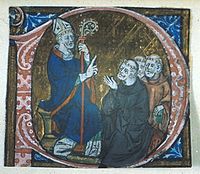Chertsey Abbey
Frithuwald of Surrey King Henry VI | |
| Site | |
|---|---|
| Location | Chertsey, Surrey, England |
| Coordinates | 51°23′42″N 0°30′11″W / 51.3950°N 0.5031°W |
| Visible remains | Yes |
| Public access | Yes |
Chertsey Abbey, dedicated to
It was founded in 666 AD by

In the 9th century it was sacked by the
Remnants
The site was given to Sir William Fitzwilliam and now only slight traces remain amongst later buildings, although the abbey is remembered in many local names (for example: Abbey River, Monk's Walk, Abbey Fields). Some very fine medieval tiles from the abbey, some depicting the legend of
One of the Abbey's bells, cast by a
A medieval stained glass panel with the abbey's coat of arms is displayed in the Burrell Collection near Glasgow, and the two crossed keys (of Saint Peter) from the arms are also in the official Banner of Arms of Surrey County Council. Some illuminated manuscripts from the abbey survive in various collections. The Chertsey Breviary, c. 1300, is in the Bodleian Library in Oxford (Bodley Ms Lat. liturg. d. 42).
Chertsey Abbey is mentioned in William Shakespeare's Richard III, Act I, Scene 2, Line 27, where Lady Anne says, "Come now towards Chertsey with your holy load", referring to the body of Henry VI.
The Worshipful Company of Haberdashers holds the advowson of St Peter's, Chertsey, nowadays.
Later history of the site
After Sir William Fitzwilliam, Chertsey Abbey was owned by Dr John Hammond (c. 1555–1617), physician to the royal household under
In the mid-19th century the site of the abbey was excavated under the supervision of the architect and archaeologist Samuel Angell, who published an account of the investigations, accompanied by a ground plan of the abbey church, in 1862.[6]
Known Abbots of Chertsey
- Erkenwaldfounder and first Abbot of Chertsey Abbey.
- Abbot Beocca, monastery sacked 875 by Vikings.[7]
- Ordbert of Chertsey 964.
- Wulfwold, Abbot of Chertsey, died 1084.
- John de Rutherwyk, 1307–46.
- John Corderoy, 1537.
Burials
- John Bourchier, 1st Baron Berners
- Abbot Beocca
- Sir Richard Berners, Knight of West Horsley
Gallery
-
Ruined wall of Chertsey Abbey
-
Erkenwaldteaching in the Chertsey Breviary (c.1300)
-
Folio 6r of the Chertsey Breviary
-
Saladin tiles in the British Museum
-
Conventual seal
-
Chertsey Abbey, plan of the Demesne from the Exchequer Ledger
-
Plan of Chertsey Abbey, showing walls, &c., excavated in 1855
-
Stone coffins excavated on site of Chertsey Abbey
References
- ^ Brekle 1997, pp. 58–63
- ^ Lehmann-Haupt 1940, pp. 93–97
- ^ Richard and Saladin; Combat Series; Chertsey tiles, British Museum page
- ^ Lehmann-Haupt 1940, p. 96f
- ^ Brekle 1997, pp. 61f.
- ^ "Proceedings at Meetings of the Archaeological Institute". The Archaeological Journal. 19: 167–8. 1862.
- ^ Chertsey Abbey Archived 2016-03-03 at the Wayback Machine history.
Bibliography
- Brekle, Herbert E. (1997). Das typographische Prinzip. Versuch einer Begriffsklärung] in Gutenberg-Jahrbuch. Vol. 72. pp. 58–63.
- Lehmann-Haupt, Hellmut (1940). Englische Holzstempelalphabete des XIII. Jahrhunderts in Gutenberg-Jahrbuch. p93–97.
Further reading
- Corner, Geo. R. (1858). . Surrey Archaeological Collections. 1. London: Surrey Archaeological Society: 77–96.
- Pocock, W. W. (1858). . Surrey Archaeological Collections. 1. London: Surrey Archaeological Society: 115–121.











